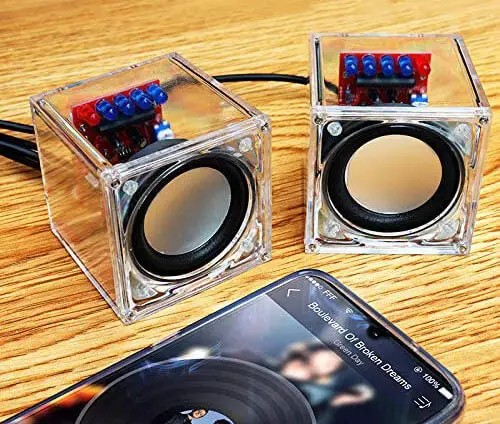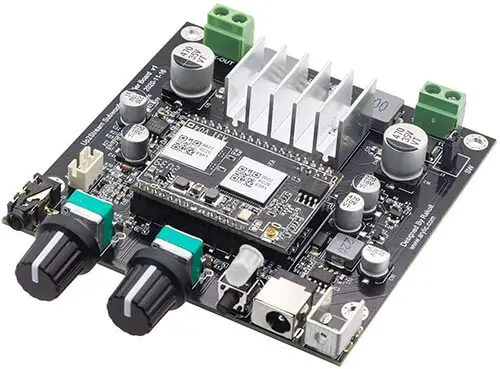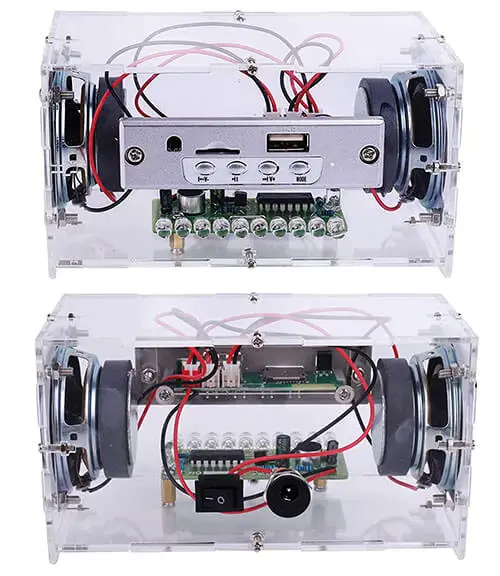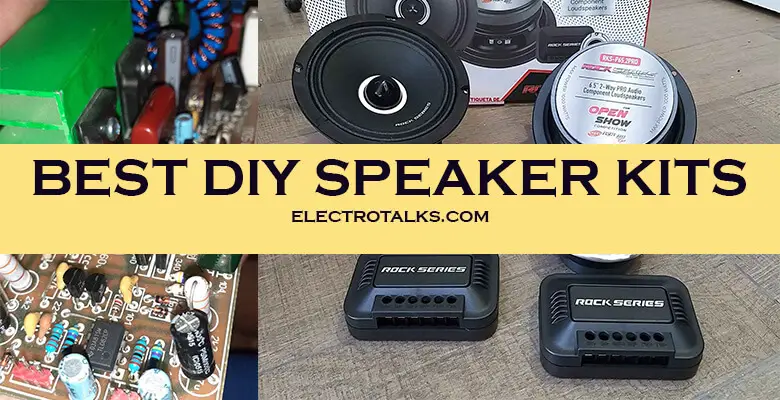“As an Amazon Associate, I earn from qualifying purchases. Without Any Extra Cost to You!”
There is a whole world of DIY kits, with pretty simple assembling, and still, you can call that your own. Ideally, DIY speaker kits on my list are suitable for both beginners and advanced users of soldering.
The kid-friendly speakers don’t require any soldering, but the advanced ones do. Many world-renowned companies are giving priority to the buyers’ wishes and making phenomenal DIY kits for them.
So, let’s start with the question: What are considerations to keep in mind before purchasing DIY Speaker Kits?
You must first decide on the sort of speaker you want before browsing for speaker components. Three-way, two-way, and full-range speakers are the three basic types of speakers. The largest of the speakers is the three-way speaker. It has three drivers. A tweeter, a midrange, and a woofer are all included.
Some speaker projects may be completed in a single weekend, while others might take years to finish. Budget speaker kits start at roughly $100, but high-end kits and components can cost thousands of dollars. Regardless of how much you spend on speakers, you’ll almost certainly wind up with something that sounds as good as a commercial device that would cost 10 times as much off the shelf.
You should also think about whether you want a vented/ported or sealed speaker. The speaker cabinet of a vented/ported speaker features a port. The port improves the speaker’s low-end performance while also expanding the cabinet’s size.
The material of choice is MDF. You don’t want sympathetic vibrations from the cabinet, so it’s not prone to resonance. Solid woods have a tendency to do this, which is why they’re fantastic for guitars and drums but not so much for cabinets. It depends on the speaker’s design, as well as a number of other elements.
There are a few things to consider when choosing components: power handling (RMS), sensitivity, size, price, sealed/vented volume, and frequency range. The volume of the speaker is determined by its power handling and sensitivity (dB). The sensitivity is defined as the volume at 1 watt.
Now, my friend, we are just getting started.
3 Best DIY Speaker Kits
We have listed the top best products that are available on the market. You can easily choose the best product from the list at a glance.
So go through the list, and you’ll find the information in detail in this article.
| Diy Speaker Kits | Specification | Available |
| Gikfun Upgraded USB Mini Amplifier Electronic Transparent Stereo Speaker Box Sound Amplifier DIY Kit | > Material: PCB + Electronic components > Speaker Power: 3W per channel > Installation: DIY welding assemble > Shell Size: 60 x 60 x 60 mm > Equipped with some nuts, screws, and other electronic components for you to do it by yourself. > The product is used for learning. Suit for people above 16 years old with a 1-year electronic DIY experience. Or use it correctly under the guidance of an electronic specializer. | On Amazon |
| Arylic Subwoofer Amplifier Board,WiFi & Bluetooth Home Audio Amplifier Board for DIY Speaker Kit | > Wireless network:IEEE802.11 b/g/n 2.4G > Ethernet: Single 10/100M RJ45 > Power Input:DC 12V – 24V DC-in,12V – 24V 2 Pin Connector > Audio Input: Analog 3.5mm jack > Audio output: Analog, Speaker out > Frequency response: 10Hz to 300Hz > Speaker Power: 100W@2Ω load at 24V,60W@4Ω load at 24V,30W@8Ω load at 24V > THD:0.1%@100Hz/1W > Speaker Impedance: 2-8ohms > Protocols: AirPlay, DLNA, UPnP, Spotify Connect, Qplay | Amazon |
| MiOYOOW Bluetooth Speaker DIY Kit with LED Flashing Light Soldering Project USB Mini Home Stereo Sound Amplifier DIY Kits | > Work Voltage: DC 3.7V-5V > Bluetooth Distance:15meters (Max) > Amplifier Power: 3W*2 > Music Source: Bluetooth/U-disk/TF Card > Control Type: Bluetooth/Remote Controller/On-Board Button > LED Color: Yellow/Green/Red/Blue > Work Temperature:-40℃~85℃Work > Humidity:0%~95%RHSize(Installed):135*74*64mm | Amazon |
1. Gikfun Upgraded USB Mini Amplifier Transparent Stereo Speaker Box Sound Amplifier DIY Kit

This electrical transparent stereo speaker kit has to be the most intriguing DIY kit you’ve ever seen; it’s a stunning speaker box with gleaming lights and a clear shell.
The product is intended for educational purposes. Suit for persons above the age of 16 with at least a year of electronic DIY expertise. Alternatively, operate it appropriately under the supervision of an electronic specialist.
It’s enjoyable to construct and attractive once completed; it’s not just a DIY kit for honing welding abilities, but it can also serve as a stereo speaker box for you.
The led lights will change color in response to the music spectrum. It might also assist you in gaining more professional expertise in the field of electronics.
This is the most recent version, which is smaller than the previous one and has a more compact circuit. Comes with an online English user manual that will walk you through the process step by step, making it ideal for classroom basic electronics experiments.
If you require technical assistance or have any other issues, please contact us through email and we will respond as quickly as possible.
If your flasher LED is self-contained, you can connect it with any two of the colors. That doesn’t even necessitate the use of a controller.
For other folks, though, this may be a little too technical. Although you won’t be able to blast the speakers when you connect them to the computer, keep the PC volume modest. Otherwise, it could come out as obnoxious!
Main Features
- Material: PCB + Electronic components
- Speaker Power: 3W per channel
- Installation: DIY welding assemble
- Shell Size: 60 x 60 x 60 mm
- Equipped with some nuts, screws and other electronic components for you to do it by yourself.
- The product is used for learning. Suit for people above 16 year’s old with 1 year electronic diy experience. Or use it correctly under the guidance of electronic specializer.
The things that might be bothering you: The only problem we faced is High wattage may melt the circuit board.
If you are interested, get this product on Amazon.
2. Arylic Subwoofer Amplifier Board,WiFi & Bluetooth Home Audio Amplifier Board for DIY Speaker Kit

It’s a snazzy little amplifier. What’s the point of being flashy? It has an excessive number of features. To be honest, I’m not sure if that’s a good thing or a bad thing.
You could be tempted to call it a benefit, but the problem is that as you add more features, the price rises as well. If an amp has too many bells and whistles, it’s unlikely that you’ll use it to its full capacity; instead, you’ll just employ part of its features.
When the audio input is sufficient and the power supply voltage/current is sufficient, the adequate output power is required. The relative strength will be greater.
The output power of different impedance horns will vary. The bigger the impedance horn, in the presence of appropriate voltage and current, the lower the relative sound power.
Reverse connection protection, over-voltage protection, under-voltage protection, over-heat protection, and short-circuit protection are all included in the BT amp’s safety features.
When activating this module, skipping songs, or stopping, there is no POP sound. The board has been updated, and the woman’s voice has been replaced by beeps to show the connection status.
The voltage can range from 12 to 24 volts, and the higher the amperage, the better. If you buy their power brick, you won’t be able to push above 100 W, and you’ll need a 24V 9.2A amp power source to achieve the amp’s full power capability.
Those are rather pricey, however, you may put up high impedance drivers and not require a high amp power brick in the first place.
Main Features
- Wireless network:IEEE802.11 b/g/n 2.4G
- Ethernet: Single 10/100M RJ45
- Power Input:DC 12V – 24V DC-in,12V – 24V 2 Pin Connector
- Audio Input: Analog 3.5mm jack
- Audio output: Analog, Speaker out
- Frequency response: 10Hz to 300Hz
- Speaker Power: 100W@2Ω load at 24V,60W@4Ω load at 24V,30W@8Ω load at 24V
- THD: 0.1%@100Hz/1W
- Speaker Impedance: 2-8ohms
- Protocols: AirPlay, DLNA, UPnP, Spotify Connect, Qplay
The things that might bother you:
It cannot be used to power heating appliances due to safety concerns.
If you are interested, get this product on Amazon.
3. MiOYOOW Bluetooth Speaker DIY Kit with LED Flashing Light Soldering Project USB Mini Home Stereo Sound Amplifier DIY Kits

Excellent soldering practice set that is also appropriate for family education. You will not only enhance your soldering abilities, but you will also gain a better understanding of electronic components and discover more intriguing facts about electronics.
Please keep in mind that this soldering kit necessitates a certain level of fundamental electronic theory understanding, as well as welding and hands-on competence.
You may become puzzled if you don’t have basic soldering and electronic expertise, despite the fact that it’s a pleasant family project. Make sure you understand the differences between surface soldering and ‘peg and hole’ soldering. The instruction can also be accessed via a QR code.
The Bluetooth module board is soldered and ready to use right away after being connected. All you have to do now is solder the LED flashing light kit, connect the wires, and put the shell together. Build your own Bluetooth Speaker for fun and entertainment.
It’s a fantastic project that’s tough enough to be enjoyable. When it comes to electricity, a 5V mobile phone charger or a computer power supply may be used; however, when the current of the power source is 2A, the sound quality will be better.
Use a 2-amp power supply and a 5-volt PC power supply or mobile charger to guarantee appropriate sound quality. When playing music, the colorful LED lights are fun to have, especially for gatherings.
We found it really difficult to put the acrylic casing together. You may also use magnets to hold the nuts in place while screwing them in.
Main Features
- Work Voltage:DC 3.7V-5V
- Bluetooth Distance:15meters (Max)
- Amplifier Power: 3W*2
- Music Source: Bluetooth/U-disk/TF Card
- Control Type: Bluetooth/Remote Controller/On Board Button
- LED Color: Yellow/Green/Red/Blue
- Work Temperature:-40℃~85℃
- Work Humidity:0%~95%RH
- Size(Installed):135*74*64mm
The things that might be bothering you: Not ideal for extensive connectivity.
If you are interested, get this product on Amazon.
Frequently Asked Questions
Question: What materials do you need to make a speaker?
Answer: Paper, metal, plastic, and aramid fiber are all common materials for speaker cones. Each of these materials has its own distinct acoustic qualities, advantages, and limitations.
Question: How do you make a speaker box from scratch?
Answer: To summarize, MDF is the most common and, in most cases, the ideal material for building a subwoofer box. You may want to use another wood, fiberglass, or something else entirely in some specialized circumstances, but if you’re looking for the gold standard, medium density fiberboard is the way to go.
Question: Do tweeters need an enclosure?
Answer: Tweeters are normally encased and do not require enclosures. Midrange drivers require their own chamber, mostly to isolate them from the bass driver (so that the bass’s pressure does not interfere with the midrange’s cone), but volume is also important since it affects the sound character.
Question: What is crossover in a speaker?
Answer: A component concealed within almost every loudspeaker is the speaker crossover. A crossover divides an unfiltered audio stream according to a specified higher or lower threshold, as the name implies. Each driver receives the signal range that it was designed to generate from the speaker crossover voltage.
Final Word
These are the 3 best DIY speaker kits you can find both on amazon and in the market. We have tried to gather them in one place to choose more comfortably.
So, what do you think of the review? Please do let us know in the comment section. Your opinions are significant for us.
Good Luck!!
